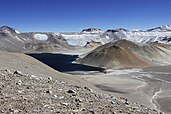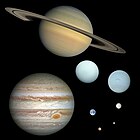User:HiDrNick/TFA blurbs
Wikipedia:Today's featured article/June 12, 2024 (edit | [[Talk:Wikipedia:Today's featured article/June 12, 2024|talk]] | history | protect | delete | links | watch | logs | views)
Incapillo is a Pleistocene-age caldera – a depression formed by the collapse of a volcano – in La Rioja Province, Argentina. It is part of the southernmost volcanic centre in the Andean Central Volcanic Zone (CVZ). Subduction of the Nazca Plate beneath the South American Plate is responsible for most of the volcanism in the CVZ. Volcanism commenced in the Incapillo region 6.5 million years ago, forming the high volcanic edifices of Monte Pissis, Cerro Bonete Chico and Sierra de Veladero. Incapillo is known to have erupted the Incapillo ignimbrite 0.52 ± 0.03 and 0.51 ± 0.04 million years ago; this has a total volume of about 20.4 cubic kilometres (4.9 cu mi). A caldera with dimensions of 5 by 6 kilometres (3.1 mi × 3.7 mi) formed during the eruptions. Later volcanism generated more lava domes within the caldera and a debris flow in the Sierra de Veladero. The lake within the caldera may overlie an area of ongoing hydrothermal activity. (Full article...)
Wikipedia:Today's featured article/June 13, 2024 (edit | [[Talk:Wikipedia:Today's featured article/June 13, 2024|talk]] | history | protect | delete | links | watch | logs | views)
The Battle of Villers-Bocage took place on 13 June 1944 during World War II. Following the D-Day landings on 6 June, the Germans established defences in front of Caen. The British attacked in an attempt to exploit a gap in the German defences west of the city. They reached Villers-Bocage without incident in the morning but were ambushed by Tiger I tanks as they left the town and numerous tanks, anti-tank guns and transport vehicles were destroyed. The Germans then attacked the town but were repulsed. The British withdrew west of Villers-Bocage that evening and repulsed another attack the next day. The British conduct in the battle was controversial because their withdrawal marked the end of the post–D-Day "scramble for ground" and the start of an attritional battle for Caen. Some historians wrote that the British attack was a failure caused by a lack of conviction among some senior commanders; others judged the British force to be insufficiently strong for the task. (Full article...)
Wikipedia:Today's featured article/June 14, 2024 (edit | [[Talk:Wikipedia:Today's featured article/June 14, 2024|talk]] | history | protect | delete | links | watch | logs | views)
The Spider was an American pulp magazine published by Popular Publications from 1933 to 1943. Every issue included a lead novel featuring the Spider, a heroic crime-fighter. The novels in the first two issues were written by R. T. M. Scott; thereafter every lead novel was credited to "Grant Stockbridge", a house name. Norvell Page, a prolific pulp author, wrote most of these. Unlike some contemporary pulp heroes, The Spider was willing to kill criminals, and when he did so he left a red spider inked on his victims. Page in particular wrote stories with violent storylines, often with science-fiction plot devices. Continuity from novel to novel was often disregarded, with characters killed in one issue appearing unscathed in later issues. Each magazine also featured short stories, occasionally including elements of horror fiction. Most of the cover art was painted by John Newton Howitt or Rafael de Soto. The magazine was cancelled in 1943 due to a paper shortage caused by World War II. (Full article...)
Wikipedia:Today's featured article/June 15, 2024 (edit | [[Talk:Wikipedia:Today's featured article/June 15, 2024|talk]] | history | protect | delete | links | watch | logs | views)
Kevin Gately died on 15 June 1974 as the result of a head injury received in the Red Lion Square public disorder in London while protesting against the National Front, a far-right, British fascist party. Gately, a 20-year-old student, was not a member of any organisation. On 15 June, the National Front held a march through central London in support of the expulsion of immigrants. A counter-demonstration was planned by Liberation, an anti-colonial pressure group. When the Liberation march reached Red Lion Square, the International Marxist Group twice charged the police cordon blocking access to Conway Hall (pictured). Police reinforcements forced the demonstrators out of the square. Gately was found unconscious on the ground. He was taken to hospital and died later that day. A public inquiry into the events was conducted by Lord Scarman, who found no evidence that Gately had been killed by the police, although he found fault with some police actions. There was further violence associated with National Front marches and the counter-demonstrations they faced, including in Birmingham, Manchester, and the East End of London (all in 1977), and in Southall in 1979, which led to the death of Blair Peach. (Full article...)
Wikipedia:Today's featured article/June 16, 2024 ([[Special:EditPage/Wikipedia:Today's featured article/June 16, 2024 |edit]] | [[Talk:Wikipedia:Today's featured article/June 16, 2024 |talk]] | [[Special:PageHistory/Wikipedia:Today's featured article/June 16, 2024 |history]] | [[Special:ProtectPage/Wikipedia:Today's featured article/June 16, 2024 |protect]] | [[Special:DeletePage/Wikipedia:Today's featured article/June 16, 2024 |delete]] | links | watch | logs | views)
Whisky Galore! is a British comedy film produced by Ealing Studios and released on 16 June 1949, starring Basil Radford, Bruce Seton, Joan Greenwood and Gordon Jackson. The directorial debut of Alexander Mackendrick, it was based on the 1947 novel Whisky Galore by Compton Mackenzie (pictured), and written by Mackenzie and Angus MacPhail. Inspired by the 1941 wreck of the SS Politician, the story concerns a shipwreck off a fictional Scottish island. The islanders, who have run out of whisky because of wartime rationing, salvage cases of it from the ship, against the opposition of the local Customs and Excise men. Like other Ealing comedies, Whisky Galore! explores the actions of a small group facing and overcoming a more powerful opponent. The film was well received on release; renamed Tight Little Island, it became the first film from the studios to achieve box office success in the US. It was followed by Rockets Galore!, a sequel. A remake was released in 2016. (Full article...)
Wikipedia:Today's featured article/June 17, 2024 (edit | [[Talk:Wikipedia:Today's featured article/June 17, 2024|talk]] | history | protect | delete | links | watch | logs | views)
The Icelandic horse is a breed of horse developed in Iceland. Developed from ponies brought to Iceland by Norse settlers in the 9th and 10th centuries, the breed is mentioned in Icelandic literature and historical records. They are long-lived, hardy, and have few diseases in their native country. In addition to the gaits typical of other horse breeds, many Icelandic horses can also do the tölt (pictured) and the flying pace. The only breed of horse in Iceland, sizable populations exist in Europe and North America. They are used for sheepherding work in Iceland, leisure, showing, and racing. Selective breeding and natural selection with the Icelandic climate developed them into their current form. In the 1780s, much of the breed was killed after a volcanic eruption at Laki. The first breed society for the Icelandic horse was created in Iceland in 1904; the breed is now represented by organizations in 19 nations organized under the International Federation of Icelandic Horse Associations. (Full article...)
Wikipedia:Today's featured article/June 18, 2024 (edit | [[Talk:Wikipedia:Today's featured article/June 18, 2024|talk]] | history | protect | delete | links | watch | logs | views)
A planet is a large, rounded astronomical body that is neither a star nor a stellar remnant. The archetypal examples are eight planets in the Solar System (all pictured): the four terrestrials, Mercury, Venus, Earth, and Mars; and the four giant planets, Jupiter, Saturn, Uranus, and Neptune. The term was initially used to denote the Sun, the Moon, and the five naked-eye planets that move across the background of the stars: they historically were seen as having associations with the gods. As scientific knowledge advanced, human perception of the planets changed. Copernicus suggested that the planets orbited the Sun and that the Earth was itself a planet, and the development of the telescope led to a broadening of the definition to accommodate other discoveries within and beyond the Solar System. Many extrasolar planets display features unseen in the Solar System. The International Astronomical Union defines a planet in the Solar System to have cleared its neighbourhood of other bodies, and that extrasolar planets should orbit stars and not be large enough to support deuterium fusion; however, many planetary scientists continue to apply the word "planet" more broadly, including dwarf planets, planetary-mass moons, rogue planets, and brown dwarfs. (Full article...)







